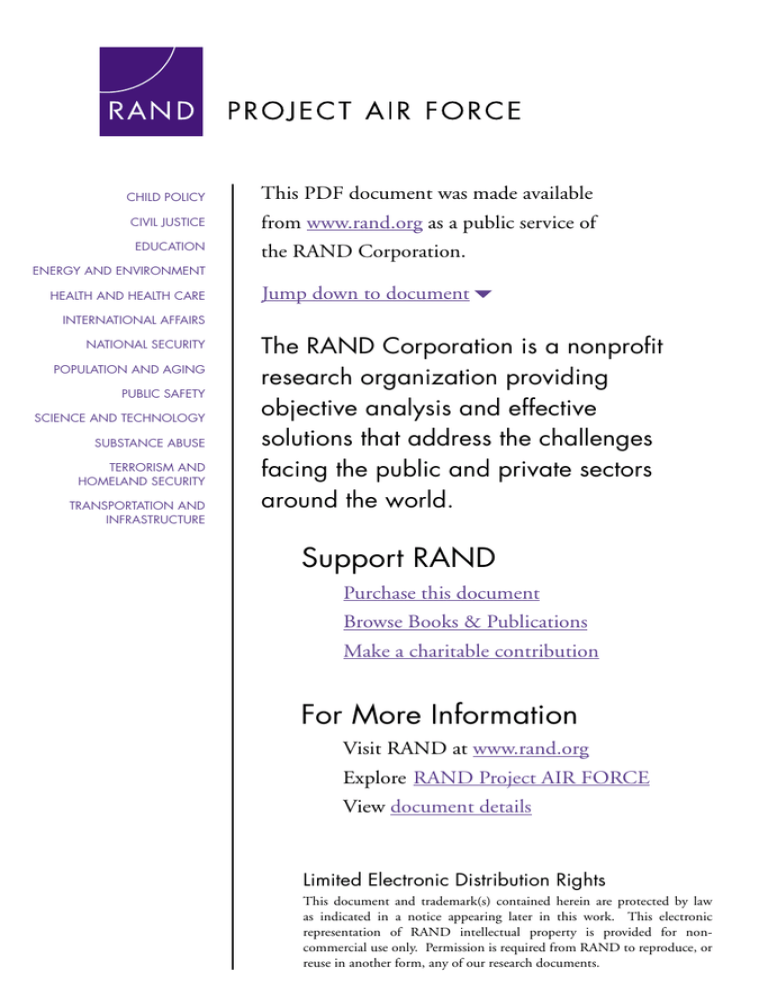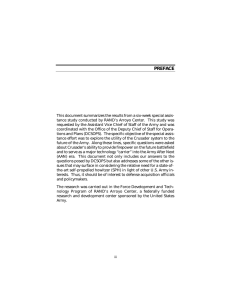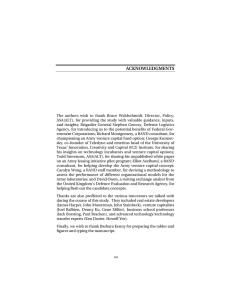
CHILD POLICY
This PDF document was made available
CIVIL JUSTICE
from www.rand.org as a public service of
EDUCATION
the RAND Corporation.
ENERGY AND ENVIRONMENT
HEALTH AND HEALTH CARE
Jump down to document6
INTERNATIONAL AFFAIRS
NATIONAL SECURITY
POPULATION AND AGING
PUBLIC SAFETY
SCIENCE AND TECHNOLOGY
SUBSTANCE ABUSE
TERRORISM AND
HOMELAND SECURITY
TRANSPORTATION AND
INFRASTRUCTURE
The RAND Corporation is a nonprofit
research organization providing
objective analysis and effective
solutions that address the challenges
facing the public and private sectors
around the world.
Support RAND
Purchase this document
Browse Books & Publications
Make a charitable contribution
For More Information
Visit RAND at www.rand.org
Explore RAND Project AIR FORCE
View document details
Limited Electronic Distribution Rights
This document and trademark(s) contained herein are protected by law
as indicated in a notice appearing later in this work. This electronic
representation of RAND intellectual property is provided for noncommercial use only. Permission is required from RAND to reproduce, or
reuse in another form, any of our research documents.
This product is part of the RAND Corporation monograph series.
RAND monographs present major research findings that address the
challenges facing the public and private sectors. All RAND monographs undergo rigorous peer review to ensure high standards for
research quality and objectivity.
Beyond Close
Air Support
Forging a New Air-Ground Partnership
Bruce R. Pirnie, Alan Vick, Adam Grissom,
Karl P. Mueller, David T. Orletsky
Prepared for the United States Air Force
Approved for public release; distribution unlimited
The research described in this report was sponsored by the United States
Air Force under Contract F49642-01-C-0003. Further information may
be obtained from the Strategic Planning Division, Directorate of Plans,
Hq USAF.
Library of Congress Cataloging-in-Publication Data
Beyond close air support : forging a new air-ground partnership / Bruce R. Pirnie ...
[et al.].
p. cm.
Includes bibliographical references.
“MG-301.”
ISBN 0-8330-3741-2 (pbk.)
1. Close air support. 2. Military doctrine—United States. 3. United States. Air
Force. I. Pirnie, Bruce, 1940–
UG700.B48 2005
358.4'142—dc22
2004030608
The RAND Corporation is a nonprofit research organization providing
objective analysis and effective solutions that address the challenges
facing the public and private sectors around the world. RAND’s
publications do not necessarily reflect the opinions of its research clients
and sponsors.
R® is a registered trademark.
© Copyright 2005 RAND Corporation
All rights reserved. No part of this book may be reproduced in any
form by any electronic or mechanical means (including photocopying,
recording, or information storage and retrieval) without permission in
writing from RAND.
Published 2005 by the RAND Corporation
1776 Main Street, P.O. Box 2138, Santa Monica, CA 90407-2138
1200 South Hayes Street, Arlington, VA 22202-5050
201 North Craig Street, Suite 202, Pittsburgh, PA 15213-1516
RAND URL: http://www.rand.org/
To order RAND documents or to obtain additional information, contact
Distribution Services: Telephone: (310) 451-7002;
Fax: (310) 451-6915; Email: order@rand.org
Summary
Recent operations in Afghanistan and Iraq have reawakened interest
in counterland operations. One battle in particular, Operation Anaconda in Afghanistan, sparked a heated debate between the Air Force
and the Army about the conduct of close air support (CAS) and led
to new efforts to improve the integration of air power and ground
power prior to Operation Iraqi Freedom. Although these efforts were
quite successful, there is growing recognition by both airmen and soldiers that air-ground cooperation is increasingly important and that
additional steps must be taken.
This report seeks to help the Air Force engage the Army in a
constructive dialogue on this issue. In particular, it addresses three
policy questions: (1) How should air attack and ground maneuver be
integrated? (2) How should the CAS terminal control function be
executed? (3) How should ground maneuver/fires and air attack be
deconflicted?
The Evolving Relationship Between Air Power
and Land Power (see pp. 20–30)
Whether air power or land power should predominate depends on
the particular military problem being considered. Depending upon
the situation, either might predominate, and their relationship is
likely to shift over the course of a campaign. At one extreme, air
power might augment the firepower of ground units, even replacing
xiii
xiv
Beyond Close Air Support: Forging a New Air-Ground Partnership
artillery in some cases. Marines habitually take this approach, and it
might also be valid for Army forces in some situations, such as an airborne assault. At the other extreme, air power might coerce an opponent or destroy his military forces in the absence of any ground
operation.
Between the extremes are three plausible alternatives, one highlighting air power, one highlighting land power, and one based on
partnership. From the perspective of a land-force commander, air
power’s greatest contribution is in weakening and impeding enemy
forces before they can close with friendly troops. From the perspective
of an air-force commander, land power’s greatest contribution is in
flushing and fixing enemy forces so that they can be destroyed by air
attack. Both perspectives are valid, but neither captures the whole
truth. The most fruitful perspective is a partnership in which either or
neither partner may predominate, depending upon the operational
and tactical situation.
There are several reasons for developing a partnership. It is the
approach most suitable to the largest number of adversaries, and it
can easily be adjusted toward greater prominence for either partner. It
gives the least opportunity for parochial claims and one-sided pleading for one’s own service. Its very difficulty could be a virtue: Once
the services have mastered partnership, they can easily revert to simpler approaches.
Partnership does not, of course, imply having co-equal commanders of the same operation, thus violating unity of command. It
implies an allocation of authority that maximizes the contributions of
each partner toward a common endeavor. Within the range of his
organic weapons (normally 30 to 40 kilometers), the land-force commander rightly expects to control air attacks. Indeed, he must have
such control in order to integrate direct fires, artillery, rockets, attack
helicopters, and fixed-wing aviation. Beyond that range, an air-force
commander should control air attacks, but with a view to assuring
successful maneuver of land forces. Neither of these commanders
need be considered supported or supporting according to doctrine,
since both work for the same joint-force commander.
Summary
xv
Trends in Counterland Operations (see pp. 31–38)
Enemy land forces were the critical target set during recent conflicts
in Kosovo, Afghanistan, and Iraq. In all of these conflicts, enemy land
forces were the only target set that was undeniably legitimate, politically acceptable, and of pivotal importance. Destroying Serb ground
forces in Kosovo would have been the most direct way to accomplish
NATO’s goal of ending the oppression of Kosovar Albanians by Serbia. Attacking Taliban ground forces in Afghanistan toppled the
Taliban regime, stripping al Qaeda of its sanctuary. Defeating Iraqi
ground forces assured the end of Ba’athist rule and made Saddam
Hussein a hunted fugitive. Moreover, in all three cases, there were
cogent political reasons for avoiding extensive damage to infrastructure. The case of Kosovo is particularly instructive because when
Milosevic capitulated, NATO had almost exhausted the targets its
members were willing to strike.
When accomplished jointly, counterland operations by air forces
are becoming ever more effective. Thanks to improved sensors and
precision munitions, air attacks are now effective at night, during extreme weather conditions, and in close proximity to friendly forces.
Moreover, the potential for fratricide is declining, thanks to improved
communications and tracking of friendly ground forces through the
Global Positioning System (GPS). The chief impediment to successful counterland operations is the inability to detect and identify enemy ground forces. Again, the Kosovo case is particularly instructive.
In the absence of a credible threat from NATO land forces, Serb
forces were free to disperse and hide in terrain that offered plenty of
cover and concealment. As a result, air attacks against them were not
effective. Indeed, Serb forces drove hundreds of thousands of Kosovar
civilians from their homes during the NATO bombing at little cost to
themselves. In contrast, indigenous opposition forces fixed Taliban
forces, making them easy targets for air attack, and coalition land
forces flushed Iraqi forces, making them reveal their positions.
Jointness is descending to lower levels of command, but current
doctrine was designed for the Cold War, when jointness tended to
reside at higher levels. Special operations forces (SOF), employed
xvi
Beyond Close Air Support: Forging a New Air-Ground Partnership
more frequently in recent years, take jointness down to the level of
very small teams. An Operational Detachment-Alpha in the Army’s
Special Forces is just a squad, yet it may operate independently, and,
normally augmented with terminal attack controllers (TACs), it may
call in large numbers of air attacks. Conventional forces are operating
at lower force levels, implying that jointness has to descend to lower
levels. In Afghanistan, for example, U.S. land forces consisted of just
one understrength brigade at the height of combat operations. In the
combat phase of operations in Iraq, the Army fielded a corps headquarters and two full divisions, but only one division led the advance,
and it usually had one brigade in front. The tendency to push jointness down to lower levels will probably accelerate as the Army fields
new forces that operate in more fluid fashion.
Key Findings (see pp. 167–170)
Key findings of this study are summarized below.
• Army Transformation is increasing Army interest in air attack.
As the Army seeks to become more strategically deployable and
agile on the battlefield, it is reducing the weight of ground-based
fires available to maneuver units. Although not yet fully detailed, the number of independent artillery brigades will shrink
as the Army shifts manpower in those units to military police
and other undermanned functions. Moreover, operations are
expected to center increasingly on independent brigades, which
will operate without or with less division and corps fire support.
These factors, combined with a newfound Army confidence in
the accuracy and responsiveness of air-delivered fires, will result
in increased Army requests for CAS and air interdiction.
• Army Transformation will increase the demand for terminal attack controllers. Current joint procedures require that a certified
TAC control aircraft conducting normal CAS missions. The
Army wants to have this capability at company level. To satisfy
Summary
xvii
this demand, the Air Force must either train more TACs or
change the way they are organized.
• The joint terminal attack controller (JTAC) program is not designed to generate a large number of certified TACs. The JTAC
program was created to ensure that TAC standards are uniform
across the services, not to produce a vast new pool of TACs.
Whether TACs are trained at a joint school or produced by the
services, the fundamental constraints remain the same: a shortage of qualified candidates, a demanding job that takes years to
master, a shortage of training facilities (ranges and simulators),
and heavy demands on strike aircraft that make it difficult for
them to generate the necessary training sorties for more than the
current TAC force.
• Operational/technological trends and manpower realities, not
service preferences, are at the heart of the TAC debate. Some
view the TAC debate as the latest event in a long struggle between airmen and soldiers over the control of air power. In our
judgment, however, the debate is driven by operational and
manpower realities, not service preferences or doctrine. The
Army recognizes a strong trend toward dispersion on the battlefield and is appropriately adapting its forces to operate in smaller
elements dispersed across a larger battle space. Such forces will
need more ready and routine access to air power. The Air Force
is correct in insisting that only fully certified, experienced, and
proficient TACs have the authority to control aircraft.
• Creative use of available technologies can free TACs to focus
on essential functions and can give engaged ground elements
greater access to joint fires. The Army does not really need
TACs with every engaged combat unit. What it needs is a system that allows engaged elements to designate targets, TACs,
and fire support officers (FSOs) at the battalion level to confirm
that no friendly forces are at the target locations, and aircrews to
independently confirm that the targets are good. The technologies discussed in Chapter Six would enable such a system. These
technologies already exist or are well along in development.
xviii
Beyond Close Air Support: Forging a New Air-Ground Partnership
• Disaggregating the TAC function is essential to ensuring that
both Army and Air Force battlefield needs are met. Identifying
TAC functions that could be delegated to engaged combat units
(e.g., target identification and geolocation) would ensure that
dispersed ground elements could easily call for air support and
would allow TACs to focus on those functions that require a
fully certified controller (e.g., aircraft control and deconfliction).
It is the only option that has a high probability of meeting Army
needs without presenting undue risk to ground and air forces.
• The doctrine for counterland operations and the associated
control measures needs revision. In current counterland doctrine, only CAS is satisfactorily defined; interdiction is poorly
defined; and strategic attack is barely mentioned. These missions
should be redefined with greater clarity, linking them unambiguously to the actual and contemplated actions of maneuver
forces. In current doctrine, the fire support coordination line
(FSCL) is unrelated to missions and is often contentious. During operations in Iraq, the 3rd Infantry Division almost overran
the FSCL because the FSCL could not be adjusted quickly
enough. At other times, the line was placed too far ahead, imposing unnecessary and counterproductive constraints on air attack. It should be redefined as the outer edge of CAS, usually at
about artillery range beyond friendly forces, i.e., the area where
integration of fires is necessary. As command and control matures, the FSCL should be replaced with a flexible system of kill
boxes. The CAS area would be defined as those kill boxes where
terminal attack control, implying control by a land-force commander, is required. Outside this area, an air-force commander
should have the authority to conduct the counterland mission,
always assuming that his efforts will complement and not run
counter to the scheme of maneuver.
• Army organic fires remain the most efficient means of meeting
routine unplanned requests. Army standards for responsiveness
in counterbattery fire are high. For example, counterbattery fire
was often delivered within two minutes of sensing the incoming
fire during Operation Iraqi Freedom. This level of responsive-
Summary
xix
ness is possible from the air for selected high-priority missions
(e.g., the leading elements in a major offensive such as the 3/7th
Cavalry during Operation Iraqi Freedom, or Special Forces conducting direct-action missions) but requires a huge force structure to sustain for prolonged operations over a large battle space.
New concepts for long-range joint fires might meet some of
these needs, but the most responsive systems (missiles) tend to
be extremely costly and are often inappropriate for small-unit
needs—and even missiles cannot meet single-digit response
times unless they are relatively close or have hypersonic speed.
Therefore, the Army should retain sufficient organic fires to
meet the routine fire support needs of dispersed units. Air forces
are best used to directly attack enemy maneuver forces throughout the depth of the battlefield, to support selected forces at
high risk, to partner with ground forces in planned offensive
operations, and to act as a theater reserve.
• Air attack and ground maneuver should be planned as mutually enabling activities. “Close air support” is an inaccurate term
that implies a one-sided relationship. In modern combat, air and
ground forces increasingly operate in mutually enabling ways.
This partnership should be encouraged. “Close air attack” is a
more accurate description of what modern air forces do in partnership with ground elements. Whenever possible, air elements
should be free to conduct deep operations against enemy maneuver forces, thereby isolating the battlefield. These operations
have the potential to deny the operational level of maneuver to
enemy motorized forces, preventing them from conducting offensive operations at the brigade or higher level. On the isolated
battlefield, friendly ground forces can operate in smaller, more
dispersed elements, finding and fixing enemy elements that increasingly will operate in small units to minimize their signature.
Air and ground forces will attack these forces cooperatively, with
air aggressively seeking enemy forces beyond the immediate line
of sight of engaged friendly forces and also providing direct support to friendly forces as needed. Finally, in this vision, ground
forces do those things they are uniquely able to do: capture and
xx
Beyond Close Air Support: Forging a New Air-Ground Partnership
hold territory, find and control weapons of mass destruction
(WMD), and enforce peace.
Recommendations for the Air Force and the Army
(see pp. 170–171)
As we look to the future, the opportunities for effective partnering of
air and ground forces are likely to grow significantly. We recommend
that the Army and the Air Force work together to develop new concepts and technologies to speed this process. In particular, training,
education, and doctrine will need to be adapted to more smoothly
integrate air attack and ground maneuver; the TAC function will
need to be disaggregated and new processes developed to effectively
designate targets while ensuring that essential oversight remains with
the TAC and the combat aircrew; and improved control mechanisms
will be needed to exploit the benefits of the digital battlefield and get
maximum benefit from the ability of air power to roam over the battlefield.
As adversaries adapt and move away from massed motorized
forces operating in the open to dispersed, smaller forces exploiting
difficult terrain, a well practiced and developed air-ground partnership will be increasingly necessary.




